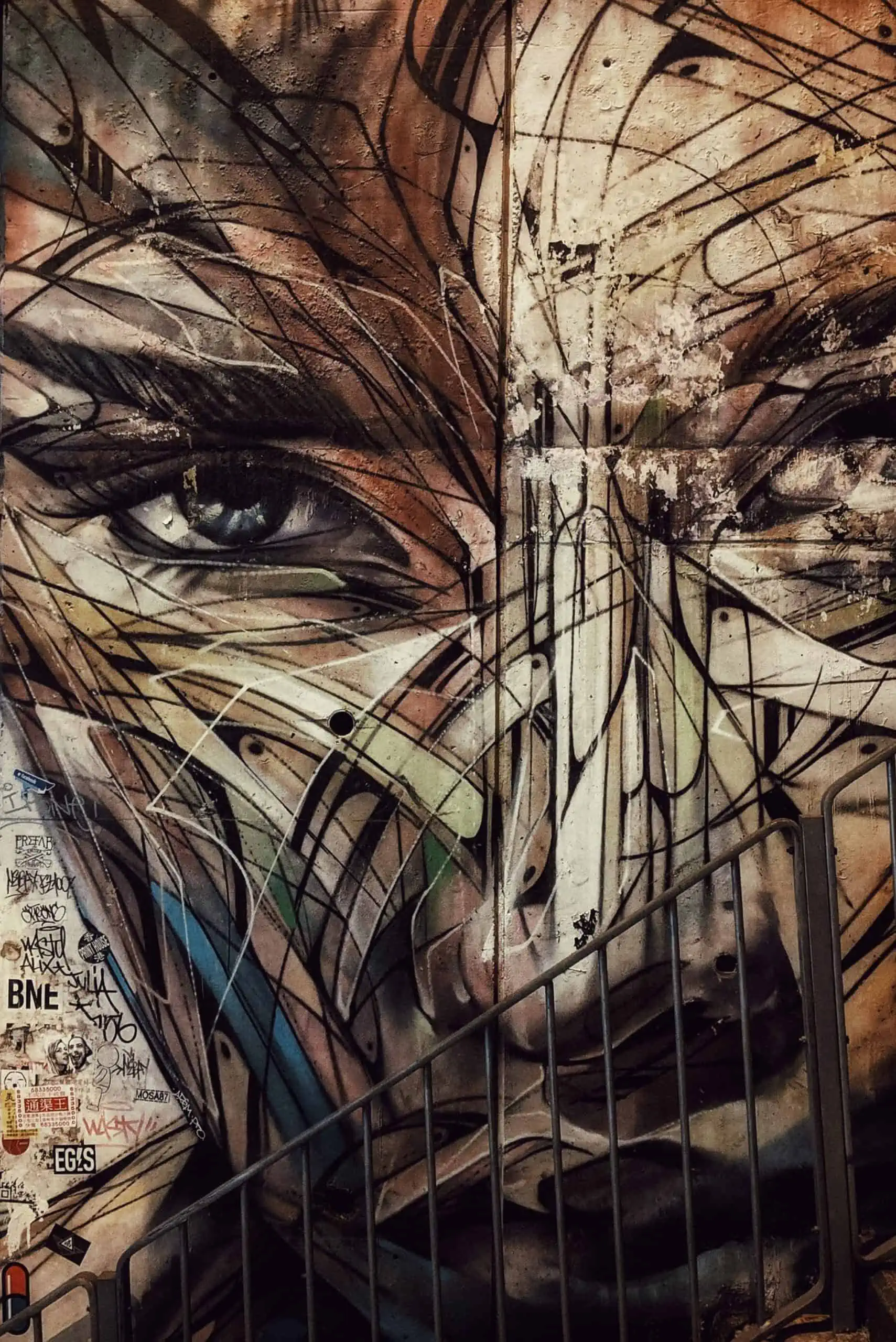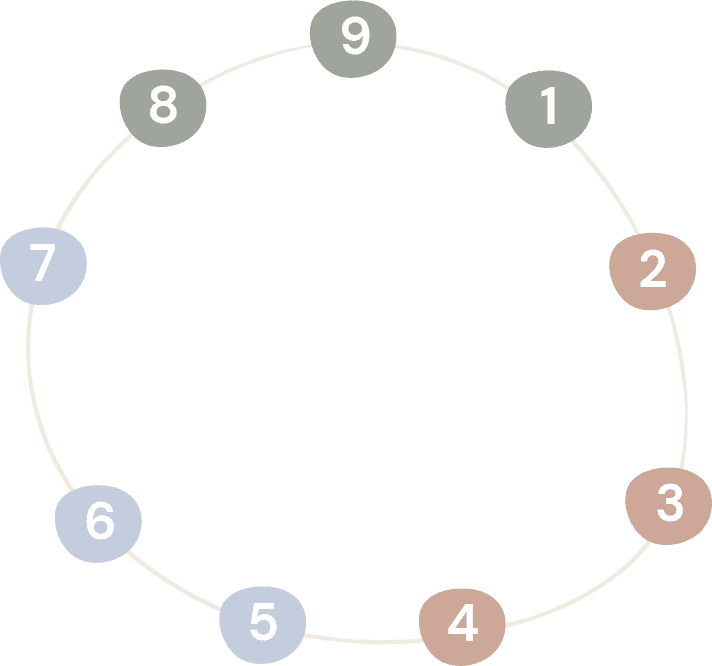
How Enneagram Groups Tell You What You Rely on the Most
Welcome to Part Four of our Enneagram Theory series!
In this series, I, Chris, chief editor and co-founder of Personality Path, go into the depths of how the Enneagram came to be and how it works.
In Part Three, you were introduced to the concept of wings. This time, you will learn about another concept: Groups.
There’s something each of us relies on the most when we navigate life. Find out what you rely on the most, and how that knowledge can help you.
What you will learn
There’s a conversation I have with my wife at least once a day that goes somewhat like this:
Her, looking at my very concerned looking face: “Hey, are you okay?”
Me, resurfacing from a deep thought dive into whatever is the latest topic I’m obsessing about: “Huh? What? Yeah, why?”
“You looked like you were angry.”
“Oh. Sorry. I was just thinking.”
“What were you thinking about?”
At this point (if she indulges me), she usually gets to hear a long monologue about personality psychology, geopolitics, science fiction literature, tabletop miniatures or one of the other quintillion interests of mine.
When I finally realize I have been talking for ten minutes straight, I eventually ask her back: “So, what were you thinking about?”
To which her usual reply is something along the lines of, “Nothing, actually. I was just looking at you and thinking how much I love you.”
What’s going on here? While I was all up in my mind thinking about theoretical and abstract concepts of all sorts, her attention was totally focused on me and her relationship with me.
And no, this is not about how all men are feeling-devoid robots and all women are hyper-relational.
It’s about what each of us relies on the most to get through the day.

Chapter 1: What Are Groups? Or: Clan Heart, Clan Brain, Clan Gut
The concept of “body, heart, mind” is an old one. It wouldn’t even make sense to call it an Enneagram idea, because you instinctively know what I’m talking about, even if this is the first time you’ve ever heard about the Enneagram.
- Classically, the body is associated with our instinctual, intuitive side, the most primal life functions of movement and survival.
- The heart has long been associated with the seat of our emotions, where our most true, honest self reveals itself.
- And finally, the mind has always been seen as the center of rational thinking, where our planning and theorizing happens.
(Note: This classical or philosophical view on the three centers of the human body should of course not be confused with actual physicality. All sensory input is processed inside the human brain, which doesn’t have these clear-cut regional distinctions between instinct, emotions, and rational thinking. They are a metaphor, albeit a useful one, which is why I use it here.)
Sorting the nine types into the three Groups
Now, the interesting thing about these three centers is that all nine personality types of the Enneagram have a special relationship to them. Neatly enough, they sort themselves into three groups of three.
- When you look at types Two, Three, and Four, you quickly realize that there’s something going on with their connection to their feelings. That’s why they are in the Heart Group.
- When you look at types Five, Six, and Seven, you can’t help but recognize a strong preoccupation with what their minds are doing. Logically, they’re in the Mind Group.
- And when you look at types Eight, Nine, and One, there is something happening on their instinctual side. So let’s put them into the Body Group.
I’m not here to explain to you how that happened or why it fits so neatly. It’s just where we are. Remember, the concepts of the Enneagram are not end-all scientific explanations of the human mind, they are helpful ways to think about the way you see the world.
But what do belonging to one of these Groups actually say about you?
Your Group isn’t what you think it is
Many times when you read about the Enneagram, the actual meaning of these Groups gets butchered. You hear things like “Heart types are especially in tune with their emotions”, or “Mind types look at the world intellectually”, or “Body types rely on their instincts.”
That’s a bit too simple.
You don’t have more feelings just because you belong to the Heart Group. You don’t think better because you’re in the Mind Group. And you don’t have a more accurate gut instinct because you belong to the Body Group.
In fact, what the Enneagram means when it talks about these Groups is that their core aspect has somehow been blocked during childhood.
As a result, the types in each Group have formed around their particular aspect, leading to the fact that it is actually the one aspect of their personality that is the least able to function freely.
- The instinctual center of the Body Group is where we gain our sense of independence from. For the types in this Group, therefore, their personality has formed around issues of autonomy. As kids, they somehow lost contact to their true sense of autonomy, and their personality grew around a false sense of autonomy as a result.
- At the feeling center of the Heart Group, you are loved and validated for who you are. For the types in this Group,Gthis appreciation for their true self wasn’t there. So in order to gain this love and appreciation, they thought they had to be someone else, and their personality formed around a substitute identity.
- Finally, the thinking center of the Mind Group is where you experience a sense of safety and security. What happens when that sense of being safe isn’t felt as a child? Your personality forms around modes to create your own support. As a result, constantly keep their minds running.
Taking it out on yourself vs. taking it out on others
When there is some core quality of life missing in your world – like the feeling of independence, of being loved for who you are, or of feeling safe and secure –, then there are two directions your efforts to reclaim that quality can go:
Towards the outside world, or towards yourself.
You could also say that you’re mainly taking out your core issues on the world around you or on yourself. As a third way, you could also try to do both at the same time.
With this last idea, we have all the ingredients to look at each of the nine types inside their respective Group in detail.
Chapter 2: Beautiful Storefronts: The Heart Group (Types Two, Three & Four)

As we just mentioned, the personality types in the Heart Group all formed because of their childhood experience that they weren’t loved for who they really are.
When you are a kid, you can’t survive without love and appreciation. So when you feel like your true self wasn’t what people wanted to see, your only option becomes to hide your true feelings and create an image of yourself that is more agreeable with your environment. That’s why, at their core, all types of the Heart Group ask themselves:
“Would anyone love me if they knew who I really am?”
The three types that evolve from this question can be sorted by the direction their efforts take:
- Type Two takes their desire to be loved towards the outside world: They become the self-sacrificial rescuers who believe that if they are always selfless, always helpful, always there for you, you will eventually give them what they want – your love. Type Two is great at giving other people the feeling of being loved, hoping that this makes them loveable and wins them appreciation. Because they believe that showing their real self and asking for what they need directly is selfish, they rarely do. But along the way, they overextend themselves, cross all sorts of healthy boundaries (their own as well as others) and end up resentful and burnt out.
- Type Four goes the other way: They take their desire to be loved towards themselves. By nurturing a self-image of being different, mysterious, and a victim of their past, they hope people will come to them, rescue them, and show them the true love they are looking for. Their answer to the question “Who do I need to be so people will love me” is “Definitely not like anybody else!” It’s like they’re saying “I don’t need anyone to tell me who I need to be”, but the paradox is that they still need you to validate their claim that they don’t need validation. Their problem is just that when you move away from people, you run the risk that they will stay where they are, and you end up feeling even more hurt, alone, and estranged.
- With Type Three, there’s a movement both outwards and inwards: Towards other people, they present an image of success, of extreme likability, of being everything and anything you want them to be. Inwardly, they try to convince themselves that their self-image is actually who they really are, fending off their deep fear that their real self isn’t as loveable as their shiny exterior. A lot of the time, type Three ends up quite successful in the eyes of others, but loses all idea of who they actually are.
As you can imagine, a common issue for all three types of the Heart Group is a deep feeling of shame about who they truly are.
- Type Two feels ashamed and guilty about their (perfectly normal and acceptable) needs.
- Type Three feels ashamed about the fact that beneath their perfect and glamorous appearance, they are just a (perfectly normal and acceptable) human being that makes mistakes like everyone else.
- Type Four is deeply ashamed about what they think everyone else has, but which they lack. Which, you might have guessed, isn’t true, because they are (say it with me) perfectly normal and acceptable like everyone else.
Chapter 3: All up in my Head: The Mind Group (Types Five, Six & Seven)

In her book “The Private Life of the Brain”, neurologist Susan Greenfield proposes the theory that consciousness and emotions are two ends of a spectrum on which we all move up and down at all times. The more purely emotional the experience, the less our “mind”, the rationalizing, interpreting, associating part of our brain, is active. Conversely, the more we engage the thinking parts of our brain, the less we are able to fully experience emotions and sensory input from our surroundings as they come in.
The Mind Group consists of types who became convinced at some point in their childhood that only by relying on their rational, conceptualizing brain, they would be able to create a sense of security and safety in their lives. They all share the same question, which goes like this:
“The world is dangerous and overwhelming. How can I think my way through this?”
As previously, it’s the direction their thinking takes that helps us understand the differences of types Five, Six, and Seven:
- Type Five directs their thinking towards themselves. They use their mind as a fortress to withdraw into. They think that by reducing their needs, stockpiling information inside their minds, and trying to go it alone, they have all the support they will need. Since they feel that strong emotions are a threat to their tenuous control on life, they become excellent at detaching from their feelings in order to look at them rationally and keep them in check. They are the type who’s most prone to get lost in a life of lonely thinking, always in preparation mode, while the real world fades more and more out of view.
- Type Seven uses their mind on the outside world: They charge into life headlong, chasing one activity after another, always keeping their brains occupied with planning the future: The next great thing, the next reward, the next adventure. The irony is that Type Seven has the hardest time enjoying any of those things, because in order to feel the joy of the moment, you would need to shut up your mind, even just for a second, and feel the moment. Type Seven, however, will already be back in their mind planning their future*.* It’s just too bad the future isn’t real. Only the present is.
- Type Six takes their overheating mind both towards others and towards themselves: To escape their inner feelings of anxiety, they launch themselves into the world. There, they constantly scan the environment to check for dangers and threats and prepare for them. But since the outside world is inherently uncertain, unpredictable, and therefore scary, their anxiety triggers, and they retreat back inside to prepare. From all the types in the Mind Group, the way type Six keeps their mind occupied tends to be the most unproductive, because it always revolves around hypothetical “What if”-scenarios.
If you never felt truly supported and safe, you naturally develop a deep, unconscious fear about the world.
- Type Five fears to be overwhelmed by everything. The world is too big, wants too much from them, is too complex, and too demanding. So they stay in school, as if life were an exam they need to cram for in order to pass.
- Type Six fears the uncertainty of everything. There are too many variables, too many scenarios, so there’s always the possibility for something to go wrong. Their solution: better stay on your toes at all times.
- Type Seven fears the present, because the present might be uncomfortable, even downright depressing. So they keep running, never allowing the dark side of life to catch up with them.
Chapter 4: In the Belly of the Beast: The Body Group (Types Eight, Nine & One)

What happens when you get threatened at the level of your most basis instincts – of survival, of being an autonomous agent in the world? Your fight or flight instincts start kicking in. You either retreat, try to fight back, or try not to move until the danger goes away.
When you are fully inside your body, you experience fullness, stability, and autonomy. But if you lack this experience, you start to create a personality that will give you this sense of autonomy and independence in some other way. This is what happened for the types in the Body Group. They all ask a variation of the question:
“How can I be in control of the world without being controlled by it?”
Each of them takes a different direction to answer this question:
- Type Eight takes their energy to the outside world. It handles reality by simply grabbing it by the neck and dragging it with them. They use their natural aggression to stay in control of the situation. Yet, to keep up this level of control, you need to be strong. Out of a deep feeling of weakness at some point in their lives, they came to the conclusion they needed to be tough and invulnerable, even if that is an unnatural toughness: Always act strong, power through, never let anyone see your weakness. It’s a good recipe for staying on top, as well as for burning out faster than a box of matches.
- Type One takes their desire for control inwards. Control for them means pushing down any inner impulse that feels threatening. By neatly categorizing everything into black and white, right and wrong, true and false, they hope that if only they stay in the “right” corner, life will remain under their control. They are the ones with the highest ideals, but also the ones who practice the most (self-)critique.
- Type Nine tries to handle reality by pacifying both themselves and the outside world. They go the way of Gandhi and simply resist non-violently until (hopefully) the problem goes away. Not only do they do their best to keep the peace with others, but also to keep the peace within themselves. Nothing should be able to rock their little boat. No wonder there’s no number on the Enneagram you get along more easily with. It’s also no wonder there isn’t a type who knows less about what they want for themselves. Theirs is an artificial peace of avoiding conflict and discomfort.
Constantly defending against the world requires a large amount of aggression. Consequently, rage is the feeling the Body Group grapples with the most.
- Type Eight often acts out their rage freely, which can make them appear like bullies and often feels intimidating to others.
- Type Nine is aggressively non-aggressive, denying that their anger even exists. Of course, this strategy only works for a limited amount of time. At some point, their anger will surface in one way or another, destroying much more of their inner peace than if they had acknowledged it right away.
- Type One pushes their anger down, suppressing, even repressing it. While trying to deny their impulses, they can build up intense resentment for their inability to be as perfect as their inner voice demands them to be. It’s exhausting, honestly.
Chapter 5: How knowing your Group (and that of others) can help you

The Enneagram is all about creating awareness for why you’re doing what you have been doing all your life. This is its main goal, its revelatory beauty, and its unique value. You get to understand yourself and others in a way that you have never before.
And you mostly do this through learning about your type.
But beyond your one-out-of-nine personality quirks, your Group give you some overarching information that can be incredibly valuable.
For example, let’s say your main type is type Eight. You might have become aware that your intensity can feel threatening to others, that your high-octane lifestyle might burn you out sooner than you think, and that making yourself vulnerable is a gift, not a knife being held to your throat.
However, if you take a step back and look at your type as part of the instinctual, intuitive-intelligence-centered Body Group, you also become aware that you are not alone in your issues with control. There’s type Nine, trying to control reality by not making any waves at all. And there’s type One, hoping to control their surroundings by working tirelessly to just get everything right.
And suddenly, you start to have more compassion for the people in your life who are shaped by these two types, and who – so far – had seemed so absurd to you.
Moreover, when you keep in mind that for all the people coming from types Five, Six, and Seven out there, life has been presented to them as a problem they had to solve through brain power alone, you might be more lenient the next time they are all up in their heads again.
Who knows, you might even learn to forgive the efforts of types Two, Three and Four to always be someone they’re not. After all, they believed all their lives that who they really are is someone no one will ever love.
The power of the Groups of the Enneagram is to show us that in all our individual differences, we are not the only ones fighting our specific battle. It reminds us that what seems totally alien to us at first might just be another shade of the same thing we’re dealing with ourselves.
This concludes Part Four of our introductory series to the Enneagram.
In Part Five, the Enneagram symbol with all its fancy lines will finally start to make sense.
Because yes, the lines have a meaning.
Hey there, I’m Chris, Chief Editor of Personality Path and the guy who wrote this article. If you want to know why the Enneagram has helped thousands of people more than any other personality assessment ever could, I’m with you. That’s what our bi-weekly newsletter wants to explore. We’re on the same journey as you. Wanna come?

